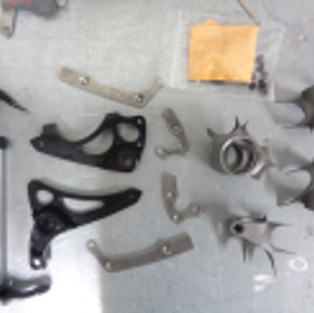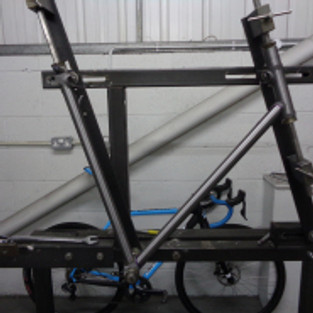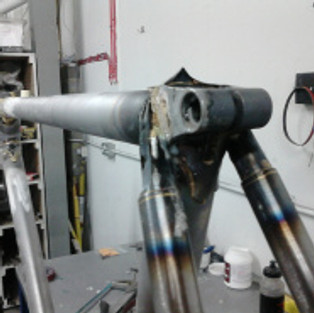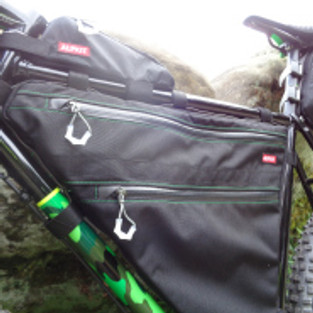onesevenfifteen/aeighttech – part 1. building the distance bike (CX-Disco)
- Jun 13, 2017
- 7 min read
Bike-Packing, Off-Road-Touring, All-Terrain, Road-Plus, Beyond-Gravel, I’m completely confused about what it is that we’re building here! But what I do know is what the bike is supposed to do and that is a. Carry enough stuff to sleep outside for a few nights, or maybe more, b. Be capable of travelling across all terrain and, c. Travel across said terrain at speed. So I built my own and it went rather well…
I’ve built a few frames now from scratch with some help from some brilliant folks, but this was the second frame that I’ve made completely on my own. It’s a pretty rewarding process to take raw tubing and lugs and create a working frame from nothing to my own spec and especially for this bike, it’s given me the chance to try some new things out – that said, I don’t want to get carried away with calling myself a framebuilder though, because I definitely don’t know enough to say that and I don’t want to be like all those other guys that do one frame-building-course and then tell the world they know everything about building bikes. To borrow a Guy Martin phrase, I’m, “not a messer”, so if anyone asks, I’m a frame-building apprentice.
The “distance bike” came about at the same time as the guys at Kinesis UK first suggested the idea of the race/ride/event which ran for the first time this weekend in Galloway, Scotland. The plan was to build a bike that can race a local ‘cross race, but can also be easily converted to ride/race an event like The Distance or Grinduro. Basically it has to be capable of taking different wheel sizes and a range of gearing options and be tough enough to handle the rough stuff. For this reason I decided to build my frame with mountain bike axles – this would mean that I could borrow the 29er wheels from my XC race bike and fit them with any kind of ‘cross tyre, and also I could experiment with fitting a 650b mountain bike wheel complete with “gravel” tyre or a full on mountain-bike tyre. I opted for 142×12 and 100×15 axles, as that’s what I’ve got on my current mountain bike.

So I started by ordering some Paragon Polydrops and some Columbus Zona and SL tubing. The Polydrops are great as I won’t have to stress about lining up the break calliper mounts and they allow me to use the newer Shimano direct mount rear mechs. The mountain-bike rear stays should allow me plenty of clearance and the mix of Zona and SL helps keep the weight down. For this build I’m sticking to a 1 1/8th headtube and lugs as I’m more confident with making this strong, but I think a lugless headtube would be a good idea next time. I’ve also decided to stick to a factory rigid mountain bike fork for the build so I started by setting the jig up for the fork, adjusted to a nice slack 71 degrees. For me I’ve gone for a more common 73 degree seat angle which will give me a nice short toptube, crucial for my long legs and short torso.
The brazing is all pretty standard stuff except for the drop-outs which need to be left un-painted and therefore can’t be made out of normal steel. Because of this I’ve slotted and silver-soldered the Paragon drop-outs in place. Previously I’ve only brazed standard drop-outs onto my frames which is pretty easy as theirs lots of adjustment right up to the final weld, but with slotted dropouts it’s a lot more difficult as you have to be perfectly accurate with alignment and tracking from the start with only a slight chance to tweak things as you go. My mate Sam, who knows a bit (and isn’t a messer either) suggested how best to do the job and for a first attempt he reckons my work cut the mustard. I’ve since ridden the frame off some fairly big drops and I’ve not had to remove the seatstays from my behind so I must have done something right.
The great thing about using lugs is there’s a bit less clean-up to do after brazing everything, but it still takes some time to make everything look good – I probably ended up using too much brass, but my thinking was that I’d better make sure everything was strong rather than fancy which left me with a fair bit of tidying up to do, but I don’t mind a bit of work with the files as long as everything ends up staying in one piece. Once that was sorted I got the guys at Enigma Paintworks to lay some camo down on the tubes – on the last bike we used a wrap, but this one is all painted and they reckon it’s about 20-25 hours work to get just right – I didn’t have the heart to tell them I was going to strap bags to it and throw it across rocky beaches, but it looked mint when we started!
I then built the bike up with a tried-and-tested Shimano groupset from last year’s race bike – a mix of Ultegra Di2, XT Di2, a Wolftooth ring and some Shimano hydraulic brakes. On the 29er/700c wheels I used a 11-32 cassete, but for The Distance I’ll use an 11-40. I stuck a custom Fizik saddle and tape on the bike to match the camo paint and initially my old 29er mountain bike race wheels, shod with the excellent Schwalbe X-One Bite tubeless tyres. This set-up would be perfect as a safety set-up as everything would work well in anything from mixed to really muddy conditions. I also experimented with another favourite of mine – the G-One Speed All-round in a 35mm and I think the 38mm version would be a great tyre for this year’s winter training.
But the big thing for this bike was to try the 650b wheels and the guys at Reynolds really stepped up to the plate here by loaning me a set of their carbon Black Label Wheels. Not only are the wheels wider than normal, they’re also lighter and with a wheel that makes a big difference – people always joke that rather than losing weight on the bike they should lose weight on their body but this is plain daft. If you understand anything about how a bike works you’ll know that wheels are “rotational weight” rather than fixed or “sprung weight” and this means that as the wheel rotates faster it effectively becomes heavier and creates more gyroscopic effect, making it harder to brake or turn the bike. Lots of other interesting things happen too but basically if you build a wheel with a light rim and then stick a light tyre on it’ll behave much better than a basic, heavy version and that’s why wheels and tyres are so important. This is true for road and off-road bikes and is one of the reasons we’ll all be riding with disc brakes eventually.
In the short-term I had pretty much the best set of wheels that you could want and they really helped when the going got rough. I stuck a set of tubeless Schwalbe Nobbie Nic’s on for The Distance as the new Addix version wasn’t quite ready – The normal version was a squeeze at 2.25 inches, but it just fitted and I can’t wait to get my hands on the newer version of the Rocket Ron Addix. Using the Nic at Dalbeattie in Scotland after The Distance I’m still in awe of how well it works on wet rock – with a rigid fork I was worried that I’d be a bit under-biked on a proper Scottish Red Trail but the Nic’s set at a nice low pressure really got me out of trouble a couple of times – big thank-you to Reynolds and Schwalbe for the help.
The finishing touch and other really special thing about my bike were the standard and custom bags that Alpkit made me. I used the Koala, Kanga and Enduro Pod that they make but they also sorted me out a fully custom Stingray framebag – you basically make a cardboard template of the main triangle of the bike that you want the bag to strap into and then they stitch everything in the UK to your spec. I decided to ditch bottles so I had them fit a divider into the bag so I can store a hydration bladder in the top section and drink through a tube/straw which comes out of the front of the bag. In the rest of my bag I have my overnight warm clothes. On the bars I have my sleeping bag as its light so it won’t affect the steering and on the back I have my one-man tent and inflatable bedroll plus room for a cooker.

Now it’s time to test the frame, the build and the set-up by riding/racing The Distance (it’s not a race, but we all know it really kind of is, so it’s probably safest to just describe it as who can do the longest distance in the shortest time – it all takes place on public land so you do have to make sure you obey the rules and don’t take anything too silly)! One thing’s for sure, I’ve got all the best kit I could hope for!…
…to be continued…
Photos by Glen Whittington.
Glen rides for the Southborough & District Wheelers. He races mountain bikes, road bikes, TT and ‘cross at local and national level. He receives personal support from Helly Hansen, Scott Sports, The Velo House, and the.æight.bicycle.cømpany. Glen runs The Velo House with Olly, a coffee shop, workshop and bike shop welcoming all cyclists and non-cyclists, based at 5 St.Johns Road, Tunbridge Wells, TN4 9TN – 01892 554 505 – glen@thevelohouse.com. He also contributes to Simpson Mag @eightbikeco #aeightracer





































Comments